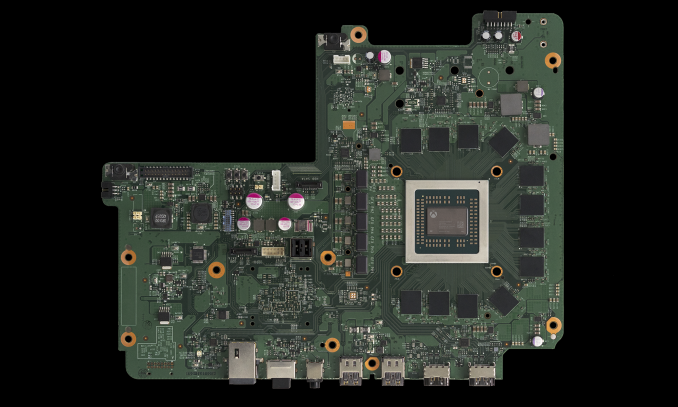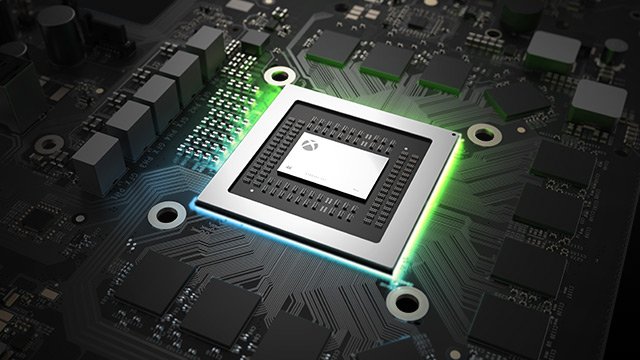The Xbox One X Review: Putting A Spotlight On Gaming
by Brett Howse on November 3, 2017 3:01 AM EST- Posted in
- Consoles
- Microsoft
- Xbox One
- Xbox
- Xbox One X
Powering Xbox One X: The Scorpio Engine
The heart of the Xbox One X is a custom AMD APU, which Microsoft is dubbing the Scorpio Engine. This APU features eight CPU cores and forty GPU compute units, essentially making it a vastly more powerful version of the APU found in the original Xbox One. All of this is built on TSMC’s 16 nm fab process, packing seven billion transistors into 360 mm2. Amazingly, that’s almost exactly the same size die as the original Xbox One, although quite a bit larger than the 240 mm2 of the Xbox One S, which is also built on TSMC 16 nm. Thanks to quite a bit of disclosure from Microsoft between the time the Xbox Project Scorpio was announced, until the launch of the Xbox One X, we know quite a bit about what’s powering the latest console.
 Image Source: Digital Foundry
Image Source: Digital Foundry
Eight Custom CPU Cores
The original Xbox One featured eight CPU cores based on the AMD Jaguar microarchitecture, and the Xbox One X keeps that completely intact. There’s still eight cores, and they are still based on a slightly upgraded version of Jaguar. Microsoft stated the CPU performance increased 31% over the original console, and they achieved that with a frequency bump from 1.75 GHz to 2.3 GHz.
This likely came down to several factors. They may have been able to leverage Ryzen cores, but it would have been difficult to get Ryzen into the new APU on the timelines required. Jaguar is also going to take up less of their die space as well, which is important when you are limited by your total die budget, and as we saw with the Xbox One’s eSRAM, taking die space for non-GPU functions can be a problem. Finally, since the Xbox One X will be completely backwards compatible with the Xbox One, keeping the same CPU architecture likely makes this an easier transition.
Microsoft calls these custom CPU cores, and while we’ll likely never get all of the information on what’s custom on them, Microsoft has released a couple of details. In particular, these new CPU cores implement a page descriptor cache of nested translations, which is a fairly low level optimization to the cache design that allows Microsoft to offset some of the remaining overhead that comes from their use of virtual machines by better caching the VM's memory operations. This optimization gets the Scorpio Engine a few percent more in average CPU performance. But regardless, the custom x86 CPU is 31% faster than the original Xbox One thanks to a 31% higher frequency. Clearly the team’s testing and research showed that this was enough CPU for the expected requirements.
12 GB GDDR5 System Memory
Arguably the biggest change to the Xbox One X is the move from 8 GB of DDR3 with a 32 MB eSRAM buffer, to 12 GB of GDDR5 memory, clocked at 6.8 Gbps. This isn’t just because there’s more RAM, but more because it gets rid of the eSRAM. The Xbox One X has twelve 32-bit channels for the GDDR5, resulting in a 384-bit memory interface. Coupled with the 6.8 Gbps data rate, that provides 326 GB/s of system memory bandwidth. 9 GB of RAM is available to developers, with 3 GB reserved for the system to handle multi-tasking. The original plan for a 4K dashboard got dropped to provide more RAM to developers, so the 3 GB matches the same reservation as the original Xbox One console.
The original Xbox One had just 68.3 GB/s of system memory bandwidth, and compensated with a 102 GB/s bi-directional eSRAM buffer. The Xbox One X no longer requires that buffer, thanks to copious amounts of bandwidth for main memory, which frees up a lot of die space on the APU. I wonder what they’ll use that space for?
40 GPU Compute Units at 1172 MHz
Microsoft was able to invest almost all of the free die space from the removal of the eSRAM into improving the GPU. The Xbox One X ships with the most powerful GPU in any console, and features an AMD custom GPU.
The heart of the Xbox One X is a GPU that's roughly based on AMD’s GCN 4 (Polaris) architecture. It offers 40 compute units, 2560 stream processors, and 32 ROPs. For comparison, an AMD Radeon RX 480 offers 36 CUs, so the Xbox One X offers 11% more compute hardware than the RX 480. Compared to the PlayStation 4 Pro, the Xbox One X offers about 43% more shader throughput.
There’s of course more custom blocks here as well. A console designed for 4K and HDR still needs to work with SDR 1080p displays, and the Xbox display controller can supersample down from 4K to 1080p, or even 1440p, as needed. There’s media blocks for HEVC as well, to handle the 4K video requirements for Blu-Ray and streaming, and the Xbox Game Capture can also capture at 4K now.
Storage: SATA HDD
For those hoping for all flash based storage in their console, those days are still a long way off. The amount of storage needed for games, especially those with 4K assets, is copious, to say the least, so for now we’re stuck with spinning disks. Digital Foundry reports that the Xbox One X will have 50% more bandwidth to the hard drive, which likely means the latest model is finally SATA III, rather than SATA II, for the 2.5” HDD. Unlike the short lived Xbox One Elite, there doesn’t appear to be any SSHD options at this time.
If you need extra storage, the Xbox One supports external USB storage. It would be nice if Microsoft had made it possible to replace the internal storage easily, but so far, they don’t seem to want to do that. Adding external storage is pretty simple though.
UHD Blu-Ray
Like the Xbox One S, the Xbox One X ships with a UHD Blu-Ray drive, allowing you to play UHD/4K movies with HDR support. There’s no support for Dolby Vision currently.
Hardware Summary
There’s a lot of performance packed into the new Xbox One X. Microsoft was too conservative with the original Xbox One, and they seem to be out to prove that they won’t make that mistake again. This is a console designed to target 4K right from the start. As to how successful they will be, that will depend on the developers, and the ever-evolving trade-off between more complex scenes, and higher resolution, but with a GPU that is almost five times more powerful than the original Xbox One, coupled with 12 GB of 384-bit GDDR5, and a faster CPU, the aim looks like its on target.













128 Comments
View All Comments
Lolimaster - Sunday, November 5, 2017 - link
Not Vega. Navi + Zen3 cores @7nm+ (probably a 6cores/12threads APU).Rufnek - Monday, November 6, 2017 - link
*cough*.Try to keep in mind they have to plan the consoles 3-5 years in advance. The next consoles will likely be a low power Ryzen (v1.5+) with a low power Vega (v1.5+). The .5 is for low power, smaller circuit refresh, the + is for specialized items in the CPU/GPU.
Hixbot - Friday, November 3, 2017 - link
I'm also disappointed with the CPU on Xbox One X. In my opinion the biggest flaw with PS4 and Xbox One is the CPU performance. A developer needs to sacrifice alot to hit 60fps, because of the poor CPUIf Xbox One X leveraged a Ryzen based APU, it would have been a 100% CPU performance increase, which would have been enough to push games that were CPU limited to 30fps to 60fps.
The 30% CPU overclock on the Xbox One X will not be enough to boost 30fps games to 60fps.
Frankly the massive GPU upgrade will allow much higher resolutions, in which is something I'm not really interested, but will not allow better framerates on CPU limited games, which is much more important to me.
InlineV - Friday, November 3, 2017 - link
It is worth noting that DirectX draw calls are no longer CPU bound. That function has been integrated, at the hardware level, into the GPU. That mitigates a potential bottleneck. Arguably, it is one of the most interesting innovations in the One X. It may never make it into commodity PC hardware but it would be significant if it did.dogen1 - Friday, November 3, 2017 - link
Technically the Xbox one already had this feature, or part of the same feature built into the GPU command processor.tipoo - Friday, November 3, 2017 - link
The article says it's still split with the GPU command processor and the CPU, but that the more powerful CP this time allows more functions to move to it.Alexvrb - Friday, November 3, 2017 - link
The CPU isn't going to hold it back in gaming. Also, this custom SoC was in development for some time before they ever started cranking them out. Redesigning it for Zen cores would have delayed it until sometime next year... and for what? More CPU horsepower isn't going to magically net them 60 FPS in gaming scenarios which are largely GPU-bound. Plus it would further complicate backwards compat (frankly I was shocked the lack of eSRAM didn't hurt them more in that department).Can't wait to see an in-depth look at all the interesting little custom bits. See InlineV's post. I want to read more about additions like that.
franzeal - Friday, November 3, 2017 - link
You'd be wrong. There are plenty of games (Assassin's Creed Unity a glaring example):https://www.youtube.com/watch?v=ZJmWsgFl6kA
StevoLincolnite - Saturday, November 4, 2017 - link
Digital Foundry has done a good game breakdown already. The CPU most certainly is a hindrance.Rufnek - Monday, November 6, 2017 - link
Digital Foundry reads like a fluff piece. Very disappointed as I tend to lean on their technical reviews.Want an actual review of good & bad and questions still unanswered... then read this.
https://arstechnica.com/gaming/2017/11/xbox-one-x-...